#hesperornithoides
Text
Caihong vs Hesperornithoides


Factfiles:
Caihong juji

Artwork by @i-draws-dinosaurs, written by @i-draws-dinosaurs
Name meaning: Rainbow with big crest
Time: 161 million years old (Oxfordian stage of the Late Jurassic)
Location: Tiaojishan Formation, China
It’s always a special treat to hear the announcement of a dinosaur with known colours, because it gives the most direct impression of how truly stunning these animals would have been to witness in real life. And Caihong might just be the most spectacular of them all so far, described in 2018 from an immaculate full-body fossil that preserves detailed feathers! Caihong’s feathers are longer than some other floofy dinosaurs, and would have had the appearance of a luxurious mane along its neck. Not only that, the fossil preserves feather microstructures that in life would have made this dinosaur gloriously iridescent!
Now iridescent dinosaurs aren’t new, Microraptor has been decked out in fabulous starling-esque plumage for a while now, but Caihong absolutely takes it to the next level. Its whole body was covered in iridescent black, including the enormous tail, but the real star of the show are the platelet-like melanosomes found on the head, neck, and the base of the tail. Different from the usual iridescent melanosomes, the structure of these tiny organelles reflects brilliantly iridescent colours, like those on the heads of hummingbirds and particularly the bright purple feathers on the necks of the trumpeter family. Caihong would have put on an absolutely dazzling jewel-toned display in the treetops or on the forest floor of prehistoric China!
Hesperornithoides miessleri

Artwork by Gabriel Ugueto, written by @zygodactylus
Name Meaning: Miessler’s Western Bird Form
Time: 156 to 147 million years ago (Kimmeridgian to Tithonian stages of the Late Jurassic)
Location: Jimbo Quarry, Morrison Formation, Wyoming
Say hello to Lori! Hesperornithoides is a vital newly named dinosaur known from material that had been excavated a few decades ago, taking that long to describe properly. You see, while we have Avialans - “protobirds” - from the Late Jurassic, we don��t have other birdy dinosaurs we’d expect from this time, such as Dromaeosaurs and Troodontids. However, with the description of Lori and other troodons from places like the Morrison, we finally have those missing links! Having more feathered dinosaurs known from times before Archaeopteryx is important for adding more robust evidence to the idea that birds are living dinosaurs - not that we need much after the discovery of the Jehol biota, but, the more evidence the better. At about a meter long and half a meter high, it is possible that Hesperornithoides was a juvenile, and may have gotten at least somewhat bigger. A slender animal with raised sickle claws, like other Troodontids, it would have looked like a small pointy bird in its environment. In fact, Hesperornithoides showcases that we have yet to find everything from the Morrison Formation - it is possible that even more mysteries lie in this interesting and famous extinct ecosystem. Lori lived in a transitional wetland environment, which would have gone through extreme seasonality. As Lori was found in a resting position, it seems that this is where Hesperornithoides lived, rather than just having been preserved there. It probably used its wings to help with predatory behaviors and in display. Its environment, the Morrison Formation, is one of the most diverse dinosaur ecosystems and one of the best known; however, its organization is something of a mess, so it isn’t clear which exact habitats Lori would have been associated with. It is a safe bet to say, however, that it lived alongside dinosaurs similar to Camarasaurus, Camptosaurus, Dryosaurus, Alcovasaurus, Gargoyleosaurus, Hesperosaurus, Stegosaurus, Haplocanthosaurus, Dyslocosaurus, Apatosaurus, Brontosaurus, Barosaurus, Diplodocus, Galeamopus, Supersaurus, Kaatedocus, Allosaurus, Fosterovenator, Coelurus, and Ornitholestes.
DMM Round One Masterpost
#dmm#dinosaur march madness#dinosaurs#dmm round one#dmm rising stars#palaeoblr#paleontology#bracket#march madness#polls#caihong#hesperornithoides
134 notes
·
View notes
Text

Hesperornithoides the western birb
101 notes
·
View notes
Text
Bite and tooth marks on sauropod dinosaurs from the Morrison Formation
Published 14th November 2023
Researchers survey fossil collections cataloging 68 sauropod bones from the Upper Jurassic Morrison Formation of the USA that bear bite traces that can be attributed to theropods, the observed bite traces show no signs of healing indicating predation or scavenger behaviour.

Examples of bite traces on Morrison Formation sauropod elements

Bite traces on a sauropod neural spine of Apatosaurus

Morrison Formation theropods and their tooth crowns, (A)Allosaurus, (B)Torvosaurus tanneri, (C) Allosaurus, (D) Ceratosaurus, (E) Marshosaurus bicentessimus, (F)Tanycolagreus topwilsoni, (G)Ornitholestes hermanni, (H)Hesperornithoides miessleri
source:
30 notes
·
View notes
Text
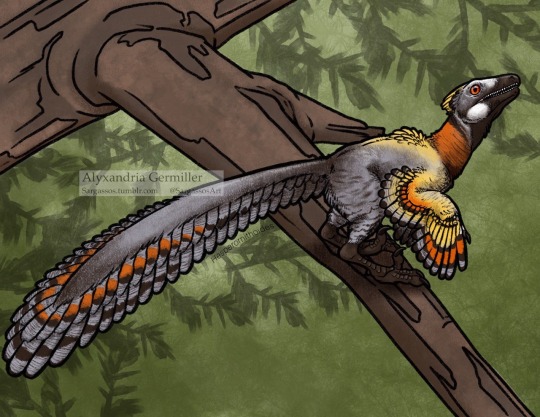
Yesterday was crazy busy, too busy to focus on drawing. So I colored instead! It took a little less focus and was a little more relaxing 😌
This was one of my Dinovember pages. He is smol and has flashy arm fluffs 🪶 Based on sunbitterns
#art#digital art#coloring#dinosaur#dinovember#dinovember coloring book#coloring page#procreate#theropod#Hesperornithoides
71 notes
·
View notes
Photo

A selection of new dinosaurs named in 2019.
#Dinosaurs#Palaeoblr#2019#Birds#Birblr#Heracles#Asfaltovenator#Gnathovorax#Suskityrannus#Convolosaurus#Vespersaurus#Hesperornithoides#Conflicto#Bajadasaurus#Avimaia#Eofringillirostrum#Elektorornis#Ambopteryx#Protodontopteryx
18 notes
·
View notes
Photo
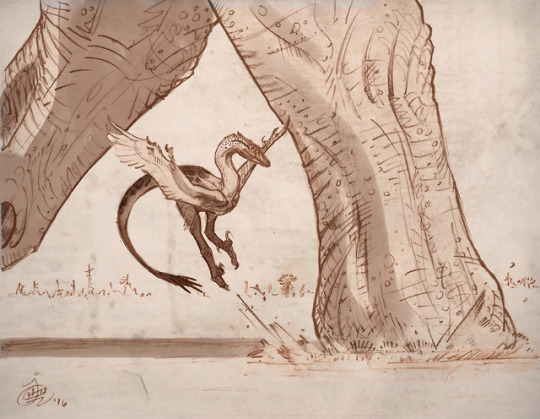
Hesperornithoides!
So a while back I did an illustration of an unnamed small theropod dinosaur (nicknamed “Lori”) to help raise funds and awareness for research. She got a name yesterday! Check out Hartman et al’s paper describing the new dinosaur:
https://peerj.com/articles/7247/
163 notes
·
View notes
Link
“In 2003, while excavating the enormous bones of a Supersaurus nicknamed “Jimbo,” Wyoming Dinosaur Center paleontologist Bill Wahl spotted something funny. About four inches above the main bone layer, in what was thought to be fossil-free rock that could be chipped away, there lay an accumulation of tiny bones.
At first, Wyoming Dinosaur Center paleontologist Jessica Lippincott says, it seemed like the remains might belong to a flying pterosaur—a non-dinosaur reptile that lived during the same time. But further examination revealed that the bones represent something never seen before: a new species of raptor-like dinosaur, the oldest yet found in North America. “We have the smallest dinosaur and the largest dinosaur found in Wyoming, both in the same quarry,” Lippincott says.
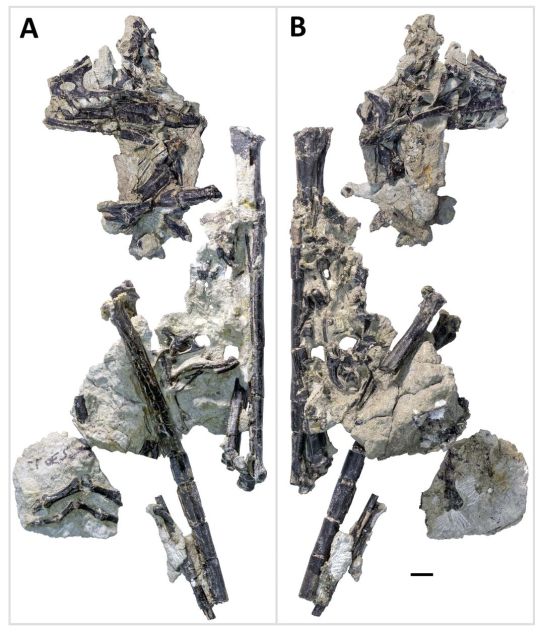
Those bones, representing a partial skeleton, were used to name the new dinosaur Hesperornithoides miessleri today in the journal PeerJ. Described by University of Wisconsin-Madison paleontologist and artist Scott Hartman and colleagues, this dinosaur is categorized as an early member of a group of svelte, small, sickle-clawed dinosaurs known to experts as troodontids. These were raptor-like dinosaurs related to the group that contains more famous carnivores like Velociraptor, as well as the forerunners of birds.”
#Hesperornithoides#Hesperornithoides miessleri#Palaeoblr#Theropod#Dinosaur#Jurassic#Mesozoic#Extinct#Prehistoric#News#Link#Article#Photo#Fossil#Bones#Info#Information#Art
126 notes
·
View notes
Photo

Hesperornithoides Sketch_Lori Tunes.
Pencils, 2019.
30 notes
·
View notes
Text
New doodles!
Just some smaller dinosaur drawings I did as part of a birthday present for a friend

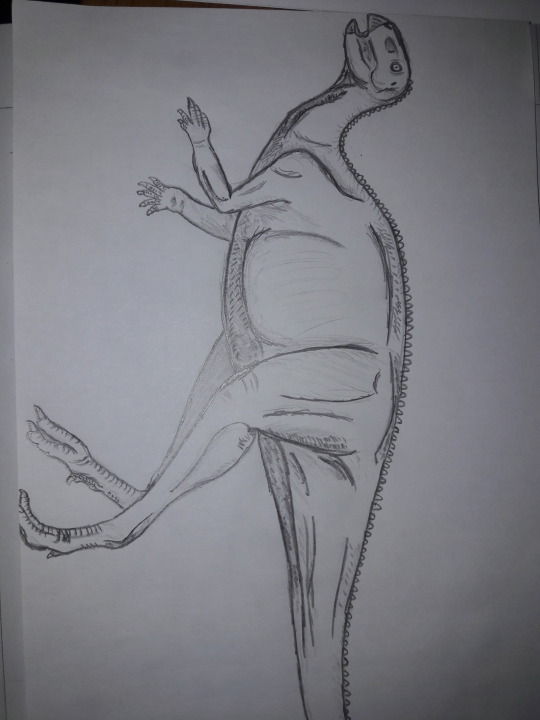
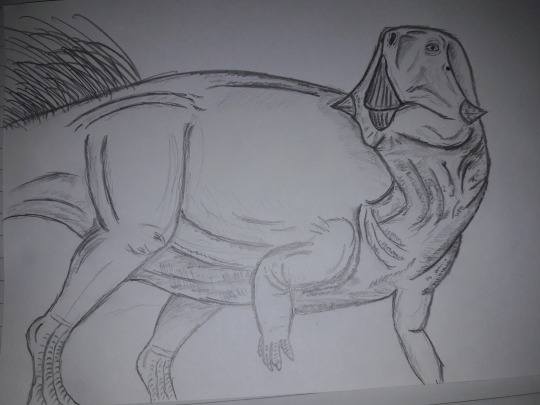
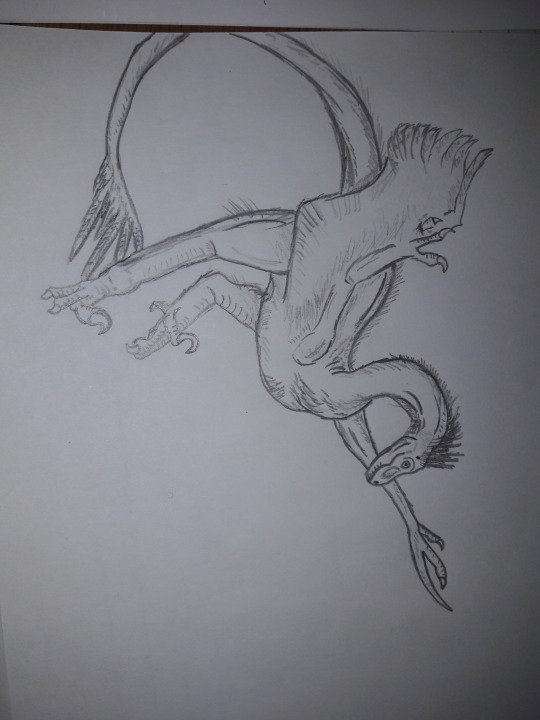
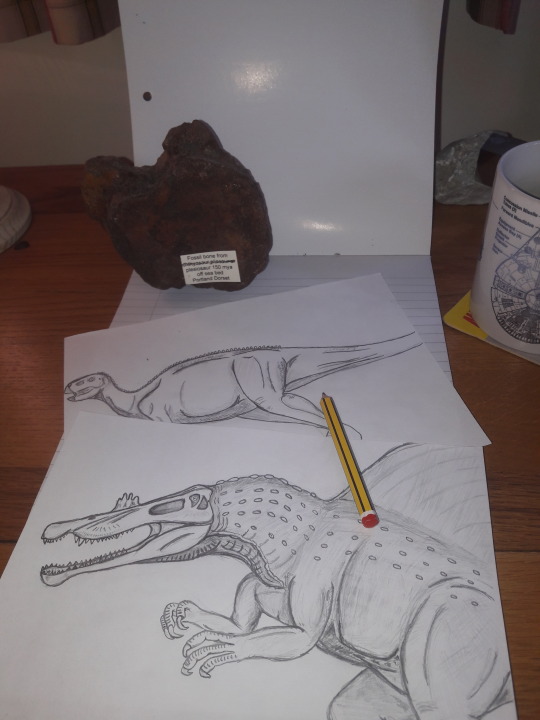
21 notes
·
View notes
Link


An article published in the journal "PeerJ" reports the identification of a new species of feathered dinosaur dating back to about 150 million years ago, in the Late Jurassic period, in today's Wyoming, USA. A team of paleontologists named it Hesperornithoides miessleri and classified it in the troodontid family, dinosaurs with various characteristics similar to birds. This species seems to be a primitive member of that group, an unusual discovery that raises new questions about the timeline of the evolution of birds and of flight in other dinosaurs belonging to groups that got extinct.
#paleontology#dinosaurs#feathered dinosaurs#fossils#Jurassic#troodontids#Hesperornithoides miessleri
0 notes
Link

At first, Wyoming Dinosaur Center paleontologist Jessica Lippincott says, it seemed like the remains might belong to a flying pterosaur—a non-dinosaur reptile that lived during the same time. But further examination revealed that the bones represent something never seen before: a new species of raptor-like dinosaur, the oldest yet found in North America. “We have the smallest dinosaur and the largest dinosaur found in Wyoming, both in the same quarry,” Lippincott says.
Those bones, representing a partial skeleton, were used to name the new dinosaur Hesperornithoides miessleri today in the journal PeerJ. Described by University of Wisconsin-Madison paleontologist and artist Scott Hartman and colleagues, this dinosaur is categorized as an early member of a group of svelte, small, sickle-clawed dinosaurs known to experts as troodontids. These were raptor-like dinosaurs related to the group that contains more famous carnivores like Velociraptor, as well as the forerunners of birds...

#bird#birds#ornithology#bird evolution#nature#science#fossils#dinosaur#prehistoric#feathered dinosaurs
21 notes
·
View notes
Note
Trick or treat! I'm a Brachiosaurus and also a sorcerer! That's not my costume it's just who I am.
Amazing

Hesperornithoides!
42 notes
·
View notes
Text
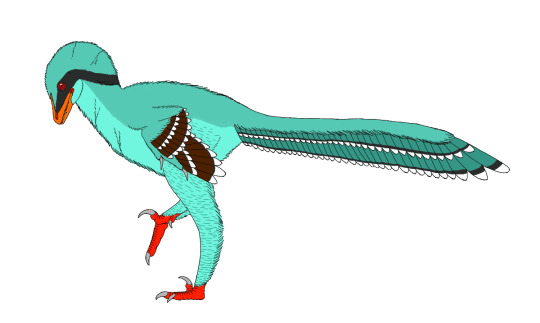
Hesperornithoides in full color.
5 notes
·
View notes
Photo

Inspired by @albertonykus‘s 50 Dinosaurs Meme.
(Answers below the break)
1) Diplodocus hallorum
2) Allosaurus fragilis
3) Tyrannosaurus rex
4) Halszkaraptor escuilliei
5) Styracosaurus albertensis
6) Parasaurolophus walkeri
7) Mononykus olecranus
8) Kelenken guillermoi
9) Gastornis gigantea
10) Butorides striata
11) Hesperornithoides miessleri
12) Iguanodon bernissartensis
13) Archaeopteryx siemensii
14) Kulindadromeus zabaikalicus
15) Giraffatitan brancai
16) Corvus splendens
17) Stegosaurus stenops
18) Deinocheirus mirificus
19) Citipati osmolskae
20) Microraptor zhaoianus
21) Psittacosaurus sp.
22) Anzu wyliei
23) Hesperornis regalis
24) Miragaia longicollum
25) Plateosaurus engelhardti
26) Europasaurus holgeri
27) Edmontosaurus annectens
28) Borealopelta markmitchelli
29) Triceratops prorsus
30) Kosmoceratops richardsoni
31) Dilophosaurus wetherilli
32) Baryonyx walkeri
33) Yutyrannus huali
34) Sinocalliopteryx gigas
35) Yi qi
36) Nigersaurus taqueti
37) Deinonychus antirrhopus
38) Pachyrhinosaurus lakustai
39) Herrerasaurus ischigualastensis
40) Ankylosaurus magniventris
41) Coelophysis bauri
42) Sauropelta edwardsorum
43) Majungasaurus crenatissimus
44) Neovenator salerii
45) Chilesaurus diegosuarezi
46) Elaphrosaurus bambergi
47) Apatosaurinae indet. (AMNH 460)
48) Acrocanthosaurus atokensis
49) Muttaburrasaurus langdoni
50) Confuciusornis sanctus
3 notes
·
View notes
Text

Woo woo, Dinovember!
The first piece for my 2021 Dinovember coloring book is Hesperornithoides!
I tried starting with this one, but didn’t like how it was turning out. So I stepped back, and started doing other random pieces from the list, and revisited it later. In the meantime, I learned that a mono-line outline brush I had made worked really well for feathers and scales, so when I got back to this, I was able to do more uniform, less awkward looking feathers.
EDIT, 1/11/22: This entire Dinovember series has been compiled and is now available for purchase on Gumroad! The pages can be printed, or thrown into a digital program! Check it out HERE!
#art#digital art#sketch#lineart#dinovember#dinovember 2021#dinosaur#dinosaurs#morrison formation#jurassic period#late Jurassic#Hesperornithoides#troodontid#theropod#coloring book#sargassos
9 notes
·
View notes
Note
Did you hear about the recent study suggesting Dakotaraptor is a unenlagiine? If so, do you think it had a more elongated skull for catching fish, since we don't have any skull fragments of it?
That would be the description of Hesperornithoides. It would be surprising if I hadn’t heard of it.
If Dakotaraptor was an unenlagiine, then there’s certainly a possibility that it had an elongated skull. We currently don’t have direct evidence either way, after all. However, as the paper notes, placing Dakotaraptor as a dromaeosaurid* is only slightly less parsimonious in their analysis, so I wouldn’t consider the unenlagiine position to be particularly well supported.
*In the most parsimonious topology found by this study, unenlagiines are more distantly related to dromaeosaurids than troodonts, and in fact the authors use a definition of Dromaeosauridae that excludes unenlagiines by default.
5 notes
·
View notes